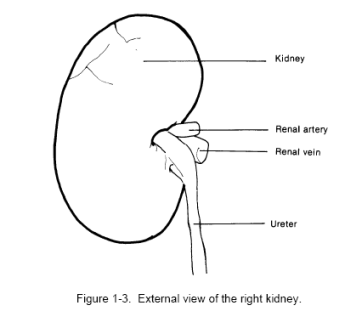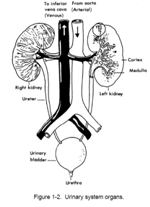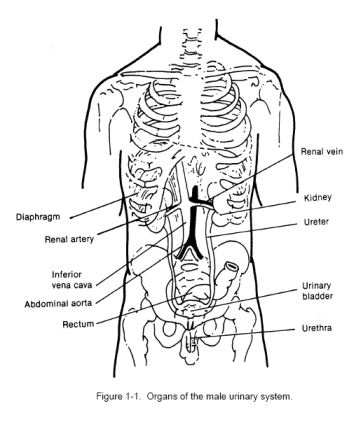INTRODUCTION
1 ANATOMY AND PHYSIOLOGY OF
THE GENITOURINARY SYSTEM
Exercises
2 PHYSICAL ASSESSMENT OF THE GENITOURINARY SYSTEM
Exercises
3 URINARY SYSTEM DISEASES/DISORDERS
Section I Urinary Tract
Infections
Section II Kidney Diseases and
Disorders
Section III Management of
Kidney Diseases
Section IV Disorders of the
Ureters
Section V Disorders Involving
the Bladder
Section VI Disorders of the
Urethra
Section VII Injuries to Organs
of the Genitourinary System
Section VIII Drug Therapy for
Genitourinary Disease/Disorders
Section IX The Effects of
Aging
Exercises
4 URINARY CATHETERIZATION
Exercises
----------------------------------
LESSON 1
ANATOMY AND PHYSIOLOGY OF THE GENITOURINARY SYSTEM
1-1. INTRODUCTION
The term "genitourinary" actually refers to two
different systems. Urinary refers to the system responsible for
removal of nitrogenous waste products of metabolism from the
bloodstream, disposal of concentrated wastes (urine), and also water
conservation. Genito refers to the genital organs and the
reproductive system, which is responsible for production of succeeding
generations for perpetuation of the species.
1-2. URINARY SYSTEM
The urinary system's primary function is to help keep
the body in homeostasis (internal environment of the body remains
relatively the same, within limits) by controlling the composition and
volume of blood. The urinary system does this by removing and
restoring selected amounts of water and solutes. The urinary system is
made up of two kidneys, two ureters, one urinary bladder, and one
urethra. Each kidney, the primary organs of this system, excretes
urine through a ureter. The urine is stored in the urinary bladder and
finally expelled from the body through the urethra. See figures 1-1
and 1-2 for organs of the urinary system
NOTE: Other systems also have a part in waste
elimination from the body. These
systems are the respiratory, integumentary, and
digestive systems
1-3. KIDNEYS
The two kidneys are reddish, bean-shaped organs. They are located
on the posterior wall of the abdominal cavity between the level of the
twelfth thoracic vertebra (T-12) and the third lumbar vertebra (L3).
Think of these organs as being just above the waist. The term for
their location is retroperitoneal, which means that they are
external to the peritoneal lining of the abdominal cavity. These
organs are about 11 to 12 centimeters long and 5 to 6 centimeters
wide. Since the liver occupies a large space on the right side of the
abdominal cavity, the right kidney is slightly lower than the left
kidney. The kidneys are held in place by fat. See figure 1-3.

From The
Genitourinary System I



